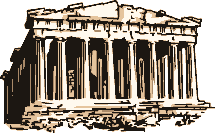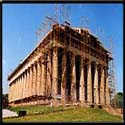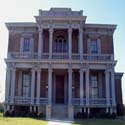
 Southern hospitality and culture go hand-in-hand with the city of Nashville. A life-size replica of the Greek Parthenon of Athens was constructed for the state's celebration of 100 years of statehood. The 1896 Centennial Exposition, bankrolled by the Railroad, was intended to promote Nashville's industry and cultural recovery from the Civil War. The event lasted for six months attracting nearly two million visitors to Nashville to see the glory and marvels of the city including the papier-mâché versions of the popular Greek Temple and Pyramid.
Southern hospitality and culture go hand-in-hand with the city of Nashville. A life-size replica of the Greek Parthenon of Athens was constructed for the state's celebration of 100 years of statehood. The 1896 Centennial Exposition, bankrolled by the Railroad, was intended to promote Nashville's industry and cultural recovery from the Civil War. The event lasted for six months attracting nearly two million visitors to Nashville to see the glory and marvels of the city including the papier-mâché versions of the popular Greek Temple and Pyramid.
 The Parthenon was such a success and glory to Nashville that it was left standing after the Exposition. By 1920, the original structure had deteriorated beyond repair, so a decision was made to attempt an authentic and lasting concrete reproduction. Eleven years was spent on that project. In 1988, The Parthenon was reopened after another two year renovation at a cost of two million dollars by Nashville architect Russell E. Hart, local Nashville architect, and William B. Dinsmoor, New York architect and archaeologist, who studied the ancient Greece ruins to draw up their blueprints. Currently underway is another twelve million dollar renovation.
The Parthenon was such a success and glory to Nashville that it was left standing after the Exposition. By 1920, the original structure had deteriorated beyond repair, so a decision was made to attempt an authentic and lasting concrete reproduction. Eleven years was spent on that project. In 1988, The Parthenon was reopened after another two year renovation at a cost of two million dollars by Nashville architect Russell E. Hart, local Nashville architect, and William B. Dinsmoor, New York architect and archaeologist, who studied the ancient Greece ruins to draw up their blueprints. Currently underway is another twelve million dollar renovation.
Encircling the Parthenon are 46 Doric columns. Two pairs of bronze doors, the largest in the world, weighing 7.5 tons each open onto floors composed of Tennessee marble and ceilings of cypress from the Florida Everglades. Ivory and gold Athena, 42 feet high in her warrior armor stands majestically inside the impressive temple. Crafted by Nashville sculptor, Alan LeQuire, the "goddess of wisdom" is the largest indoor statue in the western world. The tour of the galleries of portraits and sculptures given by guides well-versed in Greek mythology enhances appreciation for this sophisticated monument. Inside Centennial Park.
In 1993, the Parthenon was the inspiration for the Panathenaia Festival. The celebration was modeled after ancient Greek athletic competitive olympics, which were played entirely in the nude. Officials wanted to replicate authenticity as much as possible, but balked at totally naked participants. Settling for for Greek loincloths, called "perizomai", the men were rubbed with olive oil and dusted with red clay. White clay was used for the women. The games, held at the Tennessee State University, consisted of a foot race, javelin throw, discus throw, long jump and wrestling.
 Belmont Mansion, completed in 1853, was the summer plantation home of thrice married Adelicia Hayes. The 36 rooms (and there were no bathrooms) of this terra-cotta Italianate villa were decorated with original and period furnishings, art work and marble statues by American artists. The ornamented elaborate gardens contained a water tower for irrigation, green house, cast iron gazebos, bowling alley, bear house, monkeys, aviary and a lake stocked with alligators.
Belmont Mansion, completed in 1853, was the summer plantation home of thrice married Adelicia Hayes. The 36 rooms (and there were no bathrooms) of this terra-cotta Italianate villa were decorated with original and period furnishings, art work and marble statues by American artists. The ornamented elaborate gardens contained a water tower for irrigation, green house, cast iron gazebos, bowling alley, bear house, monkeys, aviary and a lake stocked with alligators.  Adelicia generously opened the grounds to the public as a park and zoo. Adelicia Hayes Franklin Acklen Cheatham with her extensive land holdings in several states was considered one of the richest women in America of the era. She often hosted moonlight parties at the Mansion to take advantage of the cool nights with the extravagant luxury of ice cubes being served with water by the many slaves. During the Civil War, Adelicia traveled to Louisiana and single-handedly negotiated the illegal sale of her cotton to England thus protecting her fortune. She was entertained in European royal courts. Today Belmont Mansion is part of a college campus owned by the Tennessee Baptist Convention. 1900 Belmont Blvd.
Adelicia generously opened the grounds to the public as a park and zoo. Adelicia Hayes Franklin Acklen Cheatham with her extensive land holdings in several states was considered one of the richest women in America of the era. She often hosted moonlight parties at the Mansion to take advantage of the cool nights with the extravagant luxury of ice cubes being served with water by the many slaves. During the Civil War, Adelicia traveled to Louisiana and single-handedly negotiated the illegal sale of her cotton to England thus protecting her fortune. She was entertained in European royal courts. Today Belmont Mansion is part of a college campus owned by the Tennessee Baptist Convention. 1900 Belmont Blvd.
Belle Meade Plantation, built in 1853 has earned the title of "Queen of the Tennessee Plantations". A long driveway leads uphill to the mansion, which is fronted by six columns and a wide veranda. Originally 5,300 acres, this Victorian showplace presently has 30 acres open to the public. Complete with carriage house, log cabin and creamery, tours are hosted in period costume. 5025 Harding Rd.
Belle Meade was one of the nation's first thoroughbred nursery and horse farms, birthplace to Iroquois, America's first native winner of the English Derby (1881). Famous thoroughbreds like Secretariat trace their bloodlines back to Iroquois. The
Iroquois Steeplechase is the only racetrack ever built by the Federal Government. Held on the second Saturday of May, the event attracts large crowds. With the exception of 1945, the steeplechase race has been held every year since 1941, making it the oldest continuously run steeplechase event in the United States.
Tennessee Botanical Gardens with it's 55 acres of flowering trees, wild and cultivated flowers, roses, orchid greenhouse, multi gardens, lawns, marble sculptures, fountains, Japanese garden, herbs, wisteria arbor, pools, streams and greenhouses was once the private estate of Leslie Cheek. In 1960, the family gave the property to the state. Cheekwood, a 1920's three story Georgian mansion, was built with Tennessee limestone quarried onsite, mahogany and fruitwood doors, majestic staircase, Adam mantel of lapis lazuli and crystal chandeliers. Filled with American artwork of the 19th and 20th centuries, Worcester porcelains, antique silver, Oriental snuff bottles, period furniture, galleries and traveling exhibitions, Cheekwood also promotes regional art and crafts inspired by nature, and is famous for the Trees of Christmas display every December. 1200 Forest Park Drive.
Clover Bottom Mansion in Donelson was built in 1858. This Italianate house is being utilized as the offices of the Tennessee Historical Commission at 294 Lebanon Road.
 An ideal example of a stately antebellum colonial home of a bygone era is the 28 room
Two Rivers Mansion. The estate derived it's name because it is located between a junction of the Cumberland and Stones rivers. In 1859, David McGavock built this early Italianate style house on land inherited by his wife, Willie, from her father, William Harding. Two Rivers Mansion is available to rent for social affairs, and is booked frequently for weddings and receptions. 3130 McGavock Pike.
An ideal example of a stately antebellum colonial home of a bygone era is the 28 room
Two Rivers Mansion. The estate derived it's name because it is located between a junction of the Cumberland and Stones rivers. In 1859, David McGavock built this early Italianate style house on land inherited by his wife, Willie, from her father, William Harding. Two Rivers Mansion is available to rent for social affairs, and is booked frequently for weddings and receptions. 3130 McGavock Pike.
Opryland's opulent 2,883-room Hotel has gorgeous outdoor gardens and three different inside gardens. are absolutely breathtaking. The two acre Conservator has thousands of tropical plants, paved walkways, streams, and statues. The Cascades centers around a dancing water fountain, the scene for elaborate laser and music productions. It has waterfalls splashing down a manmade mountain into a 12,500 square-foot lake. The Delta covers 4.5 acres and features a fountain jetting water 85 feet high, it's own river with passenger-carrying boats, food court, numerous shops and Beauregard's Restaurant. I used to visit the atrium frequently for the music, bars and fine dining, or to relax warm and cozy in front of a fireplace in the lobby, until the visitor parking got so expensive. During the Christmas holidays, the entire huge Opryland complex sparkles with more than two million lights. Imagine that electric bill! People drive from miles away causing traffic jams just to see it.
Art lovers will find an abundance of paintings, sculptures and other artwork in a variety of Nashville galleries. John F. Kennedy Center is unique in displaying artwork of children and adults with disabilities. Vanderbilt Fine Arts Gallery presents five exhibitions per year from more than 40 countries and cultures. Sarratt Gallery, also at Vanderbilt, features ten exhibits each year from regional and national artists.
Van Vechten Gallery at Fisk, originally a gymnasium built in 1888, has been renovated to house more than 100 works from the Alfred Stieglitz Collection including pieces by Picasso, Cezanne, and Renoir plus American masters, Marsden Hartley and Georgia O'Keeffe. Aaron Douglas Gallery at Fisk University has free admission to displays of African Art, a collection of masks, musical instruments, games, figures and ceremonial objects plus more than 200 drawings by Cyrus Baldridge. 18th Avenue North and Jackson St.
A new $45 million fine arts center will will be replacing the large downtown Post Office building to display works by Van Gogh, Monet, Renoir and other European masters.
The Nashville Chamber Orchestra presents six high quality musical performances in Nashville each season, and other concerts in nearby communities.
Tennessee Performing Arts Center at 505 Deaderick Street, "TPAC", is the first state funded facility of its type in the United States. Jackson Hall, the largest of three stages, seats 2,442 people. The center provides the setting for The Nashville Symphony Orchestra, Broadway musicals, Nashville Opera and concerts. Nashville Ballet presents four dance programs from classical to jazz annually with The Nutcracker performed every year. The Sunday matinees are signed for the hearing impaired.
Adventure Science Center, formerly Cumberland Museum, has both hands-on activities, permanent and changing displays, live demonstrations, animal shows. Some of the past themes have been Dinosaurs, Star Trek, and The Beat Goes On. It is a place that both children and adults will enjoy. The museum includes Sudekum Planetarium where you can see laser shows featuring our stars, constellations, moons and planets. 800 Fort Negley Blvd.
The Hartzler-Towner Multicultural Museum, on the second floor at the Scarritt-Bennett Center, features permanent and temporary exhibits of over 4,000 cultural items from around the world with an emphasis on Africa and Asia. The museum also has a collection of 700 international dolls.
The Toy Museum, located on McGavock Pike in Donelson, spans 150 years of toys. The exhibits include a model trains running through giant layouts around the store, antique dolls, wind-up train, early European bears, giant model ships, historical planes and hundreds of lead soldiers on parade in battle dioramas.
The Museum of Beverage Containers and Advertising is an overwhelming hodgepodge of more than 30,000 different beer and soda cans, thousands of antique soda bottles and antique advertisements. It is located in Millersville, just off I-65 about ten minutes from Rivergate Mall. Admission is free.
The Tennessee State Museum located in the basement of the Performing Arts Center downtown traces state and country history from prehistoric Indians to Civil War to the early 1900s. There is a rifle that belonged to Daniel Boone, a powder horn from Davy Crockett and items from both Andrew Jackson and James K. Polk. There are exhibits of local-made quilts, pottery, paintings along with silver, weapons, antebellum and Civil War artifacts. Reproductions of a log cabin, tobacco barn, woodworking shop, parlor, print shop and an exact replica of a grist mill from the 1800's are on display. 505 Deaderick Street
The Military History Branch located in the War Memorial Building, primarily focused on America's involvement in foreign wars from the Spanish American War to World War II, is a memorial to veterans. It has displays of weapons, battle histories and military clothes including hero, Sgt. Alvin York's uniform. Admission is free.
NASHVILLE
 |
HoneyHoney's Country Girl Hullaballoo |